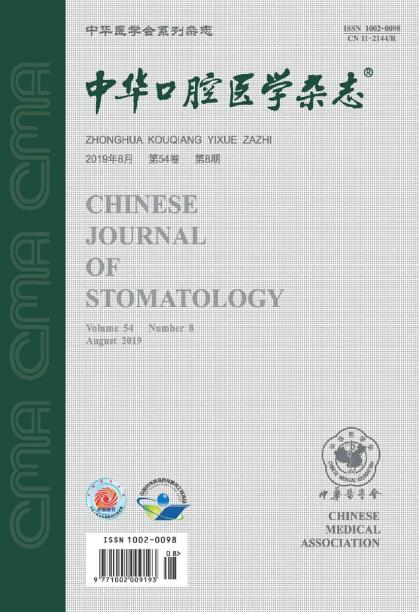肥胖对牙周炎小鼠牙槽骨吸收和肠道微生物群的影响
摘要
目的:探讨肥胖对牙周炎小鼠牙槽骨丢失及肠道菌群的影响。方法:将24只7周龄雌性C57BL/6J小鼠按随机数字表法随机分为4组(每组n=6):正常脂肪饮食组(NFD组)、高脂肪饮食组(HFD组)、正常脂肪饮食并牙周炎组(NFD_PD组)和高脂肪饮食并牙周炎组(HFD_PD组)。NFD组和HFD组分别饲喂正常或高脂饲料12周;NFD_PD组和HFD_PD组分别于正常饲粮和高脂饲粮喂养后第4周采用5-0丝线结扎双侧上颌第二磨牙诱导牙周炎。每周测量体重。第12周结束时,对小鼠实施安乐死以收集样本。称重肝脏、肾脏、肾周和腹膜后脂肪。采集血清,检测血脂及炎症因子水平。用micro-CT扫描右上颌骨。采用HE染色观察牙周组织。收集盲肠内容物进行肠道菌群16S rRNA基因测序。采用Spearman相关分析分析肠道菌群丰度与血清炎症水平及CT值的相关性。结果:高脂饲料喂养12周后,HFD组体重[(26.52±1.96)g]显著高于NFD组[(20.95±0.63)g] (t=6.63, P0.001)。HFD_PD组体重[(23.82±1.12)g]显著高于NFD_PD组[(20.73±0.47)g] (t=6.23, P=0.001)。HFD组和HFD_PD组血清总胆固醇、甘油三酯和低密度脂蛋白水平显著高于NFD组和NFD_PD组(P0.01)。HFD_PD组上颌第二磨牙近中位牙釉质牙骨质交界处到牙槽骨嵴(CEJ-ABC)的距离[(647.46±47.46)μm]显著高于NFD_PD组[(440.48±68.08)μm] (t=5.58, PPPP=0.004)。16S rRNA基因分析显示,HFD_PD组Bacteroides/Firmicutes比值(4.00±3.30)显著高于NFD_PD组(0.62±0.19)(t=2.50, P=0.030)。HFD_PD组Oscillospira丰度[(12.25±0.05)%]显著高于NFD_PD组[(2.80±0.01)%](t=4.64), PParabacteroides丰度[(0.25±0.27)%]显著低于NFD_PD组[(2.04±0.02)%](t=2.32, P=0.043)。基于Bray-Curtis距离的肠道菌群β多样性分析显示,HFD_PD组和NFD_PD组样品具有明显的分组性。相关性分析显示,示波螺旋菌的丰富度与血清中IL-1β、IL-6、MCP-1浓度和CEJ-ABC值呈显著正相关(r值分别为0.80、0.79、0.80、0.89),pvp与血清中IL-1β、IL-6浓度和CEJ-ABC值呈显著负相关(r值分别为0.71、-0.71、-0.86、-0.95)。结论:肥胖促进牙周炎小鼠牙槽骨吸收,改变肠道菌群。示波器螺旋体和副拟杆菌可能起关键作用。Objective: To study the effects of obesity on alveolar bone loss and gut microbiota in mice with periodontitis. Methods: Twenty-four seven-week-old female C57BL/6J mice were randomly divided into four groups based on table of random numbers (n=6 in each group): normal-fat diet group (NFD group), high-fat diet group (HFD group), normal-fat diet and periodontitis group (NFD_PD group) and high-fat diet and periodontitis group (HFD_PD group). NFD and HFD groups were fed with normal or high-fat diet for twelve weeks respectively; NFD_PD and HFD_PD groups were induced to periodontitis by ligating the bilateral maxillary second molars with 5-0 silk thread at the fourth week after feeding with normal or high-fat diet respectively. The body weight was measured weekly. The mice were euthanized for collecting the samples at the end of the 12th week. Liver, kidneys, perirenal and retroperitoneal fat were weighed. Serum was collected to detect the level of serum lipids and inflammatory factors. The right maxilla bones were scanned by micro-CT. HE staining was performed to observe the periodontal tissue. The cecum contents were collected for gut microbiota 16S rRNA gene sequencing. Spearman correlation analysis was performed to analyze the correlation between the abundance of gut microbiota and serum inflammatory level and CT value. Results: After 12 weeks of high-fat diet fed, the body weight of HFD group [(26.52±1.96) g] was significantly higher than that of NFD group [(20.95±0.63) g] (t=6.63, P<0.001). The body weight of HFD_PD group [(23.82±1.12) g] was significantly higher than that of NFD_PD group [(20.73±0.47) g] (t=6.23, P=0.001). The serum levels of total cholesterol, triglyceride and low density lipoprotein in HFD group and HFD_PD group were significantly higher than those in NFD group and NFD_PD group (P<0.01). The distance from the cemento-enamel junction to the alveolar bone crest (CEJ-ABC) on the mesial site of maxillary second molar in HFD_PD group [(647.46±47.46) μm] was significantly higher than that in NFD_PD group [(440.48±68.08) μm] (t=5.58, P<0.001). HE staining showed that the maxillary second molar attachment loss, collagen fiber destruction and inflammatory cell infiltration were more significant serious in HFD_PD group compared with NFD_PD group. The levels of interleukin (IL)-1β, IL-6 and monocyte chemotactic protein-1 (MCP-1) of serum in HFD_PD group [(17.11±1.92), (31.61±3.20) and (204.42±35.96) ng/L, respectively] were significantly higher than those in NFD_PD group [(10.44±1.65), (19.96±2.09) and (147.36±10.76) ng/L, respectively] (P<0.001, P<0.001, P=0.004). The 16S rRNA gene analysis revealed that the Bacteroides/Firmicutes ratio in HFD_PD group (4.00±3.30) was significantly higher than that in NFD_PD group (0.62±0.19) (t=2.50, P=0.030). The abundance of Oscillospira in HFD_PD group [(12.25±0.05) %] was significantly higher than that in NFD_PD group [(2.80±0.01) %] (t=4.64, P<0.001). The abundance of Parabacteroides in HFD_PD group [(0.25±0.27)% ] was significantly lower than that in NFD_PD group [(2.04±0.02)%] (t=2.32, P=0.043). The β-diversity analysis of gut microbiota based on Bray-Curtis distance showed that samples of HFD_PD group and NFD_PD group were obviously grouped. Correlation analysis showed that the abundance of Oscillospira was positively correlated with IL-1β, IL-6, MCP-1 concentration and CEJ-ABC value in serum significantly (r values were 0.80, 0.79, 0.80, 0.89, P<0.05). The abundance of Parabacteroides was negatively correlated with IL-1β, IL-6 concentration and CEJ-ABC value in serum significantly (r values were -0.71, -0.71, -0.86, -0.95, P<0.05). Conclusions: Obesity promotes alveolar bone resorption in periodontitis mice and changes the gut microbiota. Oscillospira and Parabacteroides may play a key role.

 求助内容:
求助内容: 应助结果提醒方式:
应助结果提醒方式:


